As a homeowner, you may wonder whether having your garbage disposal and dishwasher on the same electrical circuit is safe. It’s a common question that many homeowners have and requires careful consideration to ensure the safety of your home and family.
In this blog post, we’ve gathered expert advice on safely using your garbage disposal and dishwasher on the same circuit. We’ll cover everything from electrical safety considerations to tips on avoiding potential issues and provide you with the knowledge you need to make informed decisions about your home’s electrical setup.
What is an Electrical Circuit?
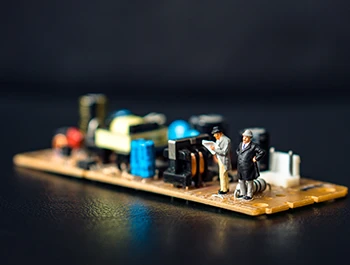
An electrical circuit is a closed loop that allows electrical current flow. A circuit consists of a power source, such as a battery or generator, wires to carry the current, and components that use the current to perform work, such as light bulbs, motors, or appliances. When a circuit is complete, the current flows from the power source through the components and back to the source, creating a continuous electricity loop.
Types of Circuits
There are two main types of electrical circuits: series circuits and parallel circuits.
1. Series Circuits
In a series circuit, the components are connected end-to-end, forming a single pathway for the current to flow. If one component fails or is removed, the circuit is broken, and the current stops flowing. This makes series circuits useful for devices that require a certain level of power, as the voltage is divided equally among the components in the circuit.
2. Parallel Circuits
In a parallel circuit, the components are connected, forming multiple pathways for the current to flow. If one component fails or is removed, the current can still flow through the other components. This makes parallel circuits useful for devices requiring a high power level, as the voltage remains constant across each component in the circuit.
Electrical Safety Tips
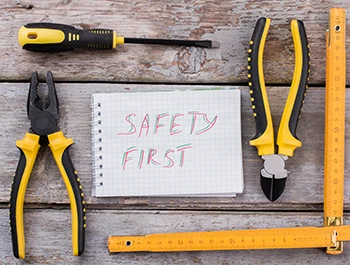
Electrical circuits can be dangerous if not handled properly, so it’s important to follow some basic safety tips to avoid injury or damage to property.
- Always turn off the power before working on a circuit. This can be done by turning off the breaker or unplugging the device.
- Use the right tools for the job. Make sure your tools are properly insulated and designed for electrical work.
- Wear protective gear. Gloves, goggles, and other protective gear can help prevent electrical shocks and burns.
- Never touch electrical components with wet hands or while standing in water. This can increase the risk of electrical shock.
- Don’t overload circuits. Ensure you know your circuit’s maximum power load and don’t exceed it.
- Use surge protectors. Surge protectors can help prevent device damage during a power surge.
In conclusion, understanding electrical circuits is important for anyone working with electricity or using electrical devices. By understanding the basics of circuits and following some basic safety tips, you can avoid injury and damage to property while working with electricity.
How a Garbage Disposal Works?
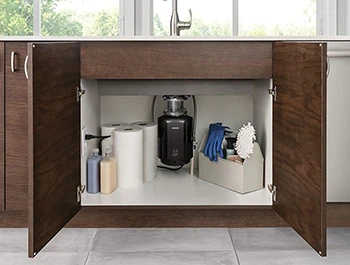
A garbage disposal device installed in a sink grinds food waste and flushes it down the drain. It consists of a motor, a grinding chamber, and a set of rotating blades. When the motor is turned on, the blades spin and grind food waste into small pieces that can be easily flushed down the drain. The ground-up food waste is then carried away by the wastewater and sent to the sewage treatment plant.
How a Dishwasher Works?
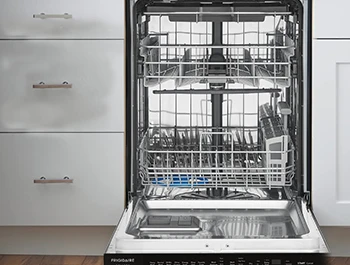
A dishwasher is a machine that cleans dishes automatically. It consists of a motor, a pump, a heating element, and a series of spray arms. When the dishwasher is turned on, water is pumped into the machine and sprayed onto the dishes by the spray arms. The water is mixed with detergent to help remove food particles and stains. Once the dishes are clean, the water is drained from the machine, and the heating element dries the dishes.
RELATED: Is It Bad To Leave Clean Dishes In Dishwasher
Common Features and Differences
Both garbage disposals and dishwashers are designed to make life easier in the kitchen. They both use motors to perform their functions and require access to water and a drain. However, there are some key differences between the two devices.
One major difference is that garbage disposals are designed for grinding food waste, while dishwashers are designed to clean dishes. Garbage disposals have rotating blades that chop food waste into small pieces, which can be easily flushed down the drain. On the other hand, dishwashers use water and detergent to remove food particles and stains from dishes.
Another difference is that garbage disposals are typically installed under the sink, while dishwashers are freestanding or built-in appliances. Garbage disposals are usually installed in the sink basin and are connected to the drainpipe. On the other hand, dishwashers are standalone appliances that sit next to the sink or are built into the kitchen cabinetry.
When a Circuit is Overloaded: Explanation and Prevention
A. Explanation of Circuit Breakers
A circuit breaker is a safety device that automatically shuts off power to a circuit when it detects an overload or short circuit. It protects the circuit and prevents damage to appliances, wiring, and other electrical components. Circuit breakers are typically located in the electrical panel of a home or building and can be reset manually after an overload has been corrected.
B. How Circuit Breakers Prevent Overloading
Circuit breakers prevent overloading by constantly monitoring the current flowing through the circuit. When the current exceeds the safe limit for the circuit, the circuit breaker trips and shuts off power to the circuit. This prevents overheating and damage to the wiring and appliances on the circuit.
C. What Happens When a Circuit is Overloaded
When a circuit is overloaded, it means that too much electrical current is flowing through the circuit. This can cause the wires to overheat and potentially start a fire. Overloading can occur when too many appliances are plugged into a single outlet or when an appliance draws more current than the circuit is designed to handle.
Symptoms of an overloaded circuit include flickering lights, tripping circuit breakers, and burning odors. If you notice any of these symptoms, unplugging any appliances on the circuit and reducing their load is important.
In extreme cases, an overloaded circuit can cause a fire. This is why it’s important to have circuit breakers installed in your home or building. Circuit breakers help prevent overloading by shutting off power to the circuit before any damage occurs.
Using a Garbage Disposal and Dishwasher on the Same Circuit: Overview and Considerations
A. Overview of the Issue
Many homeowners wonder if using a garbage disposal and dishwasher on the same circuit is safe. Both appliances require significant electrical power, which can overload the circuit if not properly managed. Overloading a circuit can be dangerous and potentially cause damage to appliances or even start a fire. Therefore, it’s important to understand the factors to consider when using both appliances and determine if the same circuit can handle the load.
B. Factors to Consider When Using Both Appliances Together
The main factors to consider when using a garbage disposal and dishwasher on the same circuit are each appliance’s power requirements and the circuit’s overall load capacity. Garbage disposals typically require between 5 and 8 amps of power to operate, while dishwashers typically require 10 and 20 amps. This means that if both appliances operate simultaneously, they could draw up to 28 amps of power.
The size of the circuit breaker and the gauge of the wiring determines the overall load capacity of a circuit. The circuit breaker is designed to trip and shut off power to the circuit if the current exceeds the safe limit for the circuit. Therefore, ensuring the circuit breaker is appropriately sized for the circuit and the used appliances is important.
C. Steps to Determine if the Same circuit can Handle Both Appliances
To determine if the same circuit can handle both a garbage disposal and a dishwasher, follow these steps:
- Identify the Circuit: Determine which Circuit the garbage disposal and dishwasher are connected to by locating the circuit breaker in the electrical panel.
- Determine the circuit’s load capacity: Check the circuit breaker’s rating to determine the maximum current capacity the circuit can handle. For example, if the circuit breaker is rated for 20 amps, the circuit can handle up to 20 amps of current without tripping.
- Determine the power requirements of the appliances: Check the manufacturer’s specifications for the power requirements of the garbage disposal and dishwasher. Add the two power requirements together to determine the total power consumption of the appliances.
- Calculate the total load on the Circuit: Divide the appliances’ total power consumption by the circuit’s voltage (typically 120 volts) to determine the total current draw. If the total current draw is less than the maximum current rating of the circuit breaker, the circuit can safely handle both appliances. If the total current draw is greater than the maximum current rating of the circuit breaker, the circuit is overloaded and cannot safely handle both appliances.
Tips for Using a Garbage Disposal and Dishwasher on the Same Circuit
Suppose you use a garbage disposal and dishwasher on the same circuit. In that case, it’s important to follow some safety tips, perform regular maintenance, and troubleshoot common issues to avoid overloading the circuit or causing damage to the appliances. Here are some tips to help you use both appliances safely and efficiently.
A. General Safety Tips
- Always turn off the appliances before working on them. This will prevent electrical shocks or accidental activation.
- Do not overload the circuit. Make sure the circuit is appropriately sized for the appliances being used.
- Never insert your hand into the garbage disposal. Always use a long-handled tool to remove any debris.
- Keep small items, such as silverware, away from the garbage disposal to prevent them from falling in and causing damage.
- Always run water when using the garbage disposal to prevent it from overheating.
- Regularly check the dishwasher’s drain line for clogs to prevent backups and damage to the appliance.
B. Maintenance Tips
- Regularly clean the garbage disposal by grinding ice cubes and citrus fruit peels to help remove any buildup or odors.
- Check the dishwasher’s filter and clean it regularly to ensure it’s functioning properly.
- Schedule routine maintenance for both appliances to help prevent breakdowns and prolong their lifespan.
- Inspect the wiring and circuit breaker for signs of damage or wear and tear, and replace them if necessary.
C. Troubleshooting Common Issues
- One must first check the power supply and reset the trash disposal if it stops operating.
- Second, if your dishwasher isn’t emptying, check for obstructions and damage to the drain pipe and pump.
- Thirdly, if the breaker keeps tripping, the circuit may be overloaded. You may lessen the strain on the circuit by switching to separate circuits or updating the appliances.
- Fourth, if your trash disposal produces strange sounds or releases odors, it may be blocked or otherwise broken. Remove any obstructions you find, or get in touch with a repairer.
- If the dishwasher isn’t doing its job, check for blockages or damage to the spray arms and detergent dispenser.
Using garbage disposal and dishwasher on the same circuit can be safe and convenient if you follow these tips. By performing regular maintenance, troubleshooting common issues, and observing general safety precautions, you can avoid overloading the circuit or causing damage to the appliances. If you need more clarification about the safety of your electrical system, it’s always best to consult a licensed electrician for advice.
When to Call a Professional Electrician?
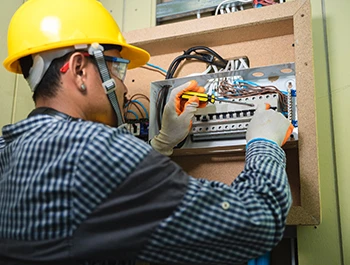
While there are many electrical repairs and installations that homeowners can handle on their own, there are certain situations when it’s important to call a professional electrician. Some signs indicate you need professional help and the importance of hiring a licensed electrician.
A. Signs that Indicate You Need Professional Help
- Circuit Breakers Tripping Frequently: If your circuit breaker trips frequently, it could indicate an overloaded circuit or faulty wiring. This is a serious safety hazard and should be addressed immediately by a licensed electrician.
- Flickering Lights: Flickering lights could be caused by loose connections, faulty wiring, or other electrical issues. This could be a sign of a more serious underlying problem that should be addressed by a professional.
- Burning Smell: If you detect a burning smell or see smoke coming from an electrical outlet or appliance, turn off the power immediately and call an electrician. This could be a sign of an electrical fire or another difficult issue.
- Outlets or Switches Not Working: An outlet or switch that isn’t working could indicate a wiring issue or a faulty device. A professional electrician can identify the cause of the problem and make the necessary repairs.
B. Importance of Hiring a Licensed Electrician
- Safety: Electrical work can be dangerous, and improper installations or repairs can lead to serious injury or death. Hiring a licensed electrician ensures the work is done safely and up to code.
- Expertise: Licensed electricians have the training and experience to handle various electrical issues. They can quickly diagnose problems and offer effective solutions.
- Liability: If an electrical installation or repair goes wrong and causes damage to your property or injures someone, a licensed electrician will have insurance to cover the damages. If you do the work yourself or hire an unlicensed electrician, you could be liable for any damages.
- Code Compliance: Electrical work is subject to strict codes and regulations to ensure safety and reliability. Licensed electricians are familiar with these codes and will ensure all work is up to code and passes inspections.
Frequently Asked Question
1. How do I know if my circuit is overloaded?
One sign that your circuit is overloaded is if your circuit breaker keeps tripping. You may also notice dimming or flickering lights, hot outlets or switches, or a burning smell. If you suspect your circuit is overloaded, it’s important to have a licensed electrician evaluate the situation.
2. Can I use a garbage disposal and dishwasher on the same circuit?
It depends on the circuit’s electrical capacity and the appliances’ wattage. Determining if the circuit can handle both appliances before using them together is important. If you’re unsure, it’s best to consult a licensed electrician.
3. Can I do my electrical work?
While homeowners can do some electrical repairs and installations, it’s important to recognize your limitations and the potential risks. Electrical work can be dangerous and, if done improperly, can lead to serious injury or even death. It’s always best to consult a licensed electrician for any electrical work.
4. How do I find a licensed electrician?
You can find a licensed electrician through recommendations from friends or family, online reviews, or by searching for licensed electricians in your area. It’s important to verify their license and insurance before hiring them.
5. How often should I have my electrical system inspected?
It’s recommended to have your electrical system inspected by a licensed electrician every ten years for an owner-occupied home. For rental properties or homes with swimming pools, it’s recommended to have an inspection every 5 years.
Final Discussion
Using a garbage disposal and dishwasher on the same circuit safely requires careful attention to electrical safety guidelines and proper installation. It’s important to understand the potential risks and take the necessary steps to avoid overloading your electrical circuit, which can lead to hazards such as electrical fires or appliance damage.
By following the expert advice in this blog post, you can ensure that your home’s electrical setup is safe and efficient for using your garbage disposal and dishwasher. Always consult a licensed electrician if you have any concerns or questions about your home’s electrical system.
